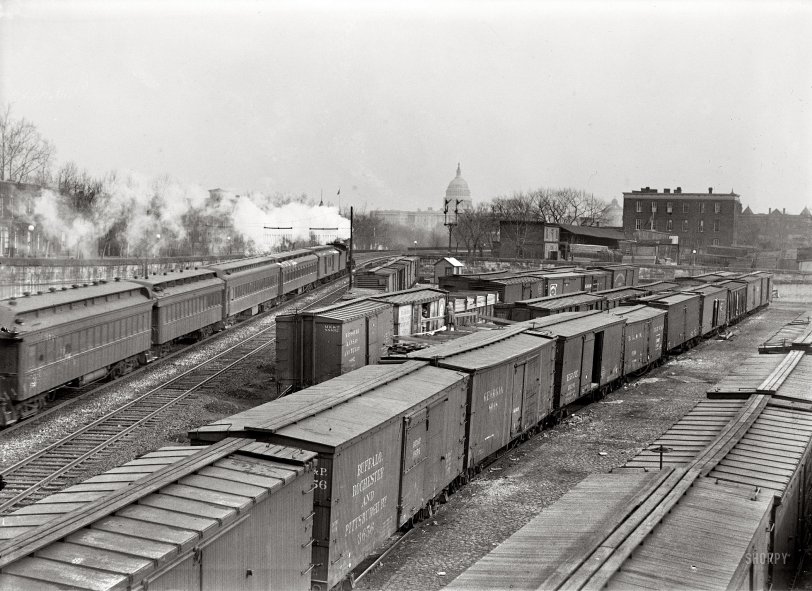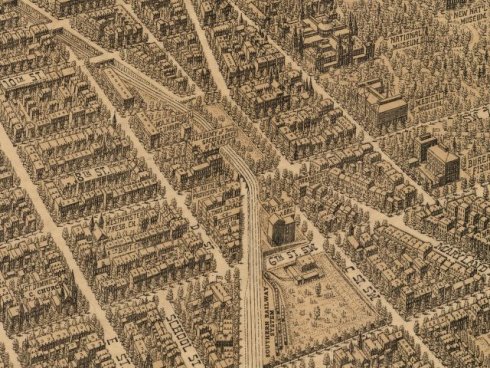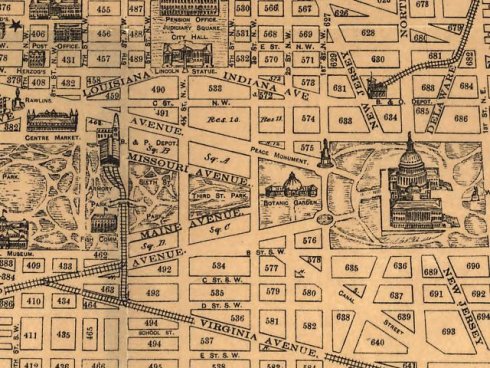


Framed or unframed, desk size to sofa size, printed by us in Arizona and Alabama since 2007. Explore now.
Shorpy is funded by you. Patreon contributors get an ad-free experience.
Learn more.

- Freeze Frame
- Texas Flyer wanted
- Just a Year Too Soon
- WWII -- Replacing men with women at the railroad crossing.
- Yes, Icing
- You kids drive me nuts!
- NOT An Easy Job
- I wonder
- Just add window boxes
- Icing Platform?
- Indiana Harbor Belt abides
- Freezing haze
- Corrections (for those who care)
- C&NW at Nelson
- Fallen Flags
- A dangerous job made worse
- Water Stop
- Passenger trains have right of way over freights?
- Coal
- Never ceases to amaze me.
- Still chuggin' (in model form)
- Great shot
- Westerly Breeze
- For the men, a trapeze
- Tickled
- Sense of loneliness ...
- 2 cents
- Charm City
- What an Outrage
- Brighton Park
Print Emporium
Washington Yard: 1917

Washington, D.C., circa 1917. "U.S. Capitol dome from rail yards in Southeast section." Harris & Ewing Collection glass negative. View full size.
Swayback
Most of the boxcars in this picture had wooden frames. To help support the center of the 40' long cars, two to four metal rods were run between the ends and below "queensposts" at the center of the car. The rods were called truss rods as they provided support similar to the trusses of a bridge. One rod is visible below the "Georgia" car. The rods had turnbuckles at their centers to provide some adjustment of their tension. Many years of heavy loads and hard use overcame even the ability of the truss rods to defy the law of gravity, and cars gradually developed the swayback appearance seen here. Iron, and later steel, underframes and sides eliminated the sag in all but the most abused cars.
Model railroaders who model this period spend many hours building that sway into brand new models.
About those dangly things and ownership
I sinned, in that I submitted a too wide image. This is a repeat of the message, with a suitably edited copy of the image. I apologize.
I found a panoramic drawing on the Library of Congress web site, dated 1921 which shows the area in question, but looking in from the east south east, I've attached an snippet from that view.
I believe the photographer was standing on the 10th Street SW overpass, and that bridge was the reason for the telltales seen in the photo.
As to the owner of the yard/team tracks, the panorama marked the tracks approaching the area as "Southern Railway System." Look between 6th and 5th streets. There is another such notation just out of the frame on the top.
The dome peeking out between the bare tree and the three story building appears to be the Library of Congress building, what they now call the Thomas Jefferson Building.

About the B&P Railroad
While I don't think the yard pictured was owned by the B&P, that railroad did have facilities nearby at one time. Attached is a bit of an 1886 map showing the pre-union station arrangements. Note the B&P station between 6th and 7th streets on the north side of the mall. An d of course, the B&P did eventually become part of the PRR.
The yard in the photo is in th eblock marked 386, right at the left edge of the map snippet.

Dangling things
Please tell me what the dangling things are off of the pole in the left center of the picture and what purpose they served.
[Overheight telltales for any brakemen on top of the cars. To let them know that a bridge, tunnel etc. is coming up. - Dave]
Ninth and D
This would not be the Southern yards, which were in Alexandria. This is a small PRR (I believe ex-B&P) yard that occupied the land bordered by Ninth and D streets SW. This Google Street view is as close as one can get to the photographer's vantage looking north east. By the time of this photo, Washington Union Station had been open for nine years. The passenger train is headed that way on the present elevated alignment which was built concurrent with Union Station.
Making a mark on society
Thankfully, the spray can hadn't been invented yet.
Team Tracks
The brick paving and the variety of railroads represented leads me to believe these are what were known as "Team Tracks," or "Public Tracks," meaning cars (mainly boxcars) were spotted on them for loading and unloading by shippers using their own "teams" (as in teamsters) without railroad employee assistance. Team Tracks were ubiquitous in the pre-highway era, and they didn't completely disappear until around 1970. A large percentage of carload freight shipments were handled this way. The shipper obtained a lower rate, and you were not required to have your own rail spur ("Private Track").
This service was available to anyone, including individuals. When my great-grandparents were moving between cities in the early 1900s, they ordered a boxcar to be placed at a local Public Track, arranged to have their household belongings loaded into it, and then reversed the process at another Public Track at their new town of residence. Of course, for more prosperous clientele, moving or transfer companies would take care of all that for you, and such companies probably would have their own warehouse and private tracks.
This was how transportation worked before paved roads.
Horse head
Peeking out at the very end of the longest line of freight cars. Maybe there to take a load of something off the waiting cars.
Southern Railroad yards
This is the Southern RR yards located in the Southwest section of DC. The view of the Capitol is the West Front with the Library of Congress dome to the right of the Capitol. The passenger line from the south ran under the mall in front of the West Front of the Capitol to Union Station
Fallen Flags
I find it very interesting that out of all of the railroads represented by these freight cars only the Florida East Coast still exists with the same name.
For train lovers
This doesn't have much to do with this photo specifically, but I think the train enthusiasts who are likely to like this picture will also very much enjoy this link.
This is a sort of documentary made in the 40's about the Southern Pacific Railroad. It gets shown on a cable access station here quite a lot (probably because Tucson has a large rail yard and some of the film was shot here), and I always find myself getting sucked into watching it when it's on.
"This Is My Railroad," Part 1:
http://www.archive.org/details/ThisIsMy1940
Part 2:
http://www.archive.org/details/ThisIsMy1940_2
It's a great record of the attitudes and mindset of the period (though it comes across as laughably sexist at times!).
























On Shorpy:
Today’s Top 5